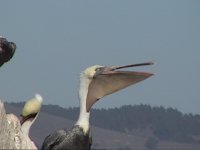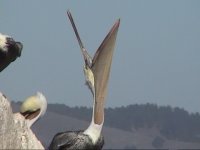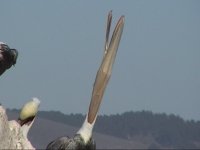Back when I first saw brown pelicans hunting I noted a curious aspect about their feeding process. Brown pelicans utilize several different hunting methods. On that occasion they were using their spectacular high aerial dive method. As I observed various individuals engaging in dives I was interested to see if they had succeeded in catching their targeted prey. So, I watched to see if, after hitting the water, they made a swallowing motion which would then signify that the individual had succeeded in catching its prey. What I observed was that in each of the successful dives there was a curious pause before the bird finally jerked its head up and back to swallow its prey. At that time I surmised what the logical reason probably was for that pause but the pelicans were too distant to allow me to obtain visual confirmation of this. It wasn’t until a later date that I finally had close enough observations of hunting pelicans to confirm what I had suspected. What I had reasoned was that when the bird opened its beak to engulf its prey and then closed it tightly to secure the prey, it also secured a large mouthful of seawater within its amazing, balloon-like lower beak pouch. I thus logically reasoned that the bird certainly didn’t want to swallow this mouthful of seawater and so what was probably happening during the pause was that the bird drained the seawater out of its beak before then swallowing the prey. And this is just what I saw during these close observations. If an individual’s attempt had been unsuccessful, while pointing its beak sharply downward it would immediately open its beak and expel the seawater. However, if successful the bird would keep its beak (with its pouch now ballooned-out with seawater) tightly closed. Then, with its beak pointed sharply downward, it began the process of draining the seawater out. It cracked its beak just slightly enough the let the water drain out while still retaining its prey. At this point I could see the seawater simultaneously drain out of both sides of its beak, the outflow progressively proceeding along from top to bottom as the pouch emptied. It was when the water had finished draining out that the bird finally flipped its head up and back to swallow its prey. This is an example of the kind of fine detail about a particular behavior that often can escape notice if the behavior is just casually observed.
-
Welcome to BirdForum, the internet's largest birding community with thousands of members from all over the world. The forums are dedicated to wild birds, birding, binoculars and equipment and all that goes with it.
Please register for an account to take part in the discussions in the forum, post your pictures in the gallery and more.
An Interesting Detail Regarding Feeding by Brown Pelicans (2 Viewers)
- Thread starter pbgrebe
- Start date






